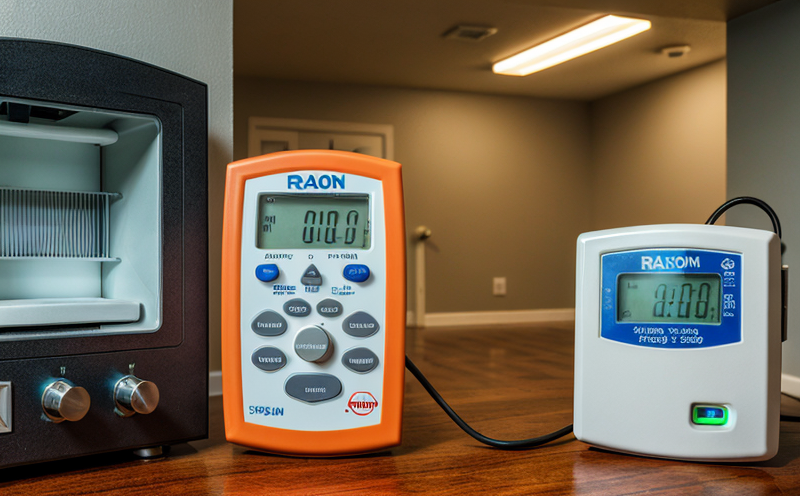ISO 11665-7 Radon Exhalation Rate Measurement from Building Materials
The measurement of radon exhalation rates from building materials is crucial for ensuring the safety and health of occupants in buildings. This service focuses on adhering to ISO 11665-7, which specifies a method for determining the radon exhalation rate from building materials using the charcoal canister adsorption technique.
The process involves several key steps. First, samples are taken from various building materials such as concrete, bricks, and mortar to ensure that all relevant components are covered by this testing protocol. After sampling, these specimens undergo rigorous preparation which includes cleaning, drying, and conditioning according to ISO 11665-7 guidelines.
The most critical part of the procedure is the use of charcoal canisters where the samples are placed. These canisters capture radon gas emitted by the materials over a specified period, typically 24 hours or more depending on the specific requirements outlined in ISO 11665-7. Once this time has elapsed, the canisters are analyzed using alpha spectrometry to measure the concentration of radon within them.
The results from these analyses provide valuable data about the potential for radon release from different types of building materials used during construction projects. This information is essential not only for regulatory compliance but also for enhancing indoor air quality standards, especially in regions known for high levels of naturally occurring radon gas.
It's important to note that while ISO 11665-7 provides a standardized approach to measuring radon exhalation rates, it does not address all aspects of radon management. For comprehensive solutions regarding radon mitigation strategies and other testing methods like uranium content determination in building materials, additional services may be required.
| Standard | Description |
|---|---|
| ISO 11665-7 | SPECIFICALLY FOR MEASURING RADON EXHALATION FROM BUILDING MATERIALS USING CHARCOAL CANISTER TECHNIQUE |
The expertise gained through adherence to such international standards ensures accurate and reliable results, which can significantly impact decision-making processes in construction and renovation projects.
Applied Standards
The measurement of radon exhalation rates from building materials is governed by several key standards. Primarily, ISO 11665-7 serves as the cornerstone for this methodology, providing detailed procedures on how to collect and analyze samples effectively.
| Standard | Description |
|---|---|
| ISO 11665-7 | SPECIFICALLY FOR MEASURING RADON EXHALATION FROM BUILDING MATERIALS USING CHARCOAL CANISTER TECHNIQUE |
In addition to ISO 11665-7, other relevant standards include ASTM D7983 which deals with the determination of radon emanation rates from soils and materials. These standards collectively form a robust framework that laboratories like ours follow meticulously.
Industry Applications
The application of ISO 11665-7 in radiation & nuclear testing is particularly relevant for the construction industry where ensuring low levels of radon emissions from building materials is paramount. By complying with these standards, builders can minimize risks associated with high indoor radon concentrations that could lead to adverse health effects.
This service also plays a vital role in research and development activities aimed at improving material properties for future generations of safer buildings. Understanding the radon exhalation characteristics helps designers and architects make informed choices when selecting appropriate materials for new constructions or renovations.
Moreover, this testing method supports regulatory bodies responsible for setting limits on acceptable levels of radon in indoor environments. Compliance with these regulations not only protects public health but also fosters confidence among consumers regarding the quality assurance practices implemented by construction firms.
Eurolab Advantages
At Eurolab, our commitment to excellence in radiation & nuclear testing is reflected in every aspect of our services. When it comes to ISO 11665-7 radon exhalation rate measurement from building materials, we bring unparalleled expertise and precision.
We utilize state-of-the-art equipment tailored specifically for this type of analysis, ensuring accurate measurements that meet the highest standards set forth by international organizations. Our experienced professionals ensure that samples are handled with care throughout each step of the process, from collection to final evaluation.
Our rigorous quality control measures guarantee consistent and reliable results every time. Whether you're a quality manager looking for assurance that your products comply with regulatory requirements or an R&D engineer seeking detailed insights into material performance under specific conditions, Eurolab offers unparalleled support tailored precisely to meet your needs.
We pride ourselves on delivering services that exceed expectations, providing comprehensive reports accompanied by detailed explanations whenever necessary. This level of transparency ensures complete confidence in the reliability and accuracy of our findings.





